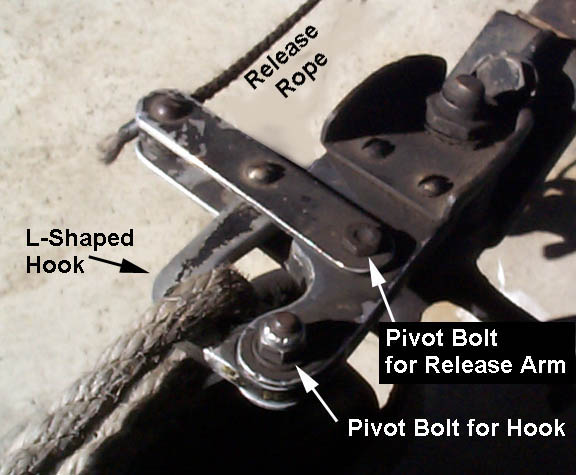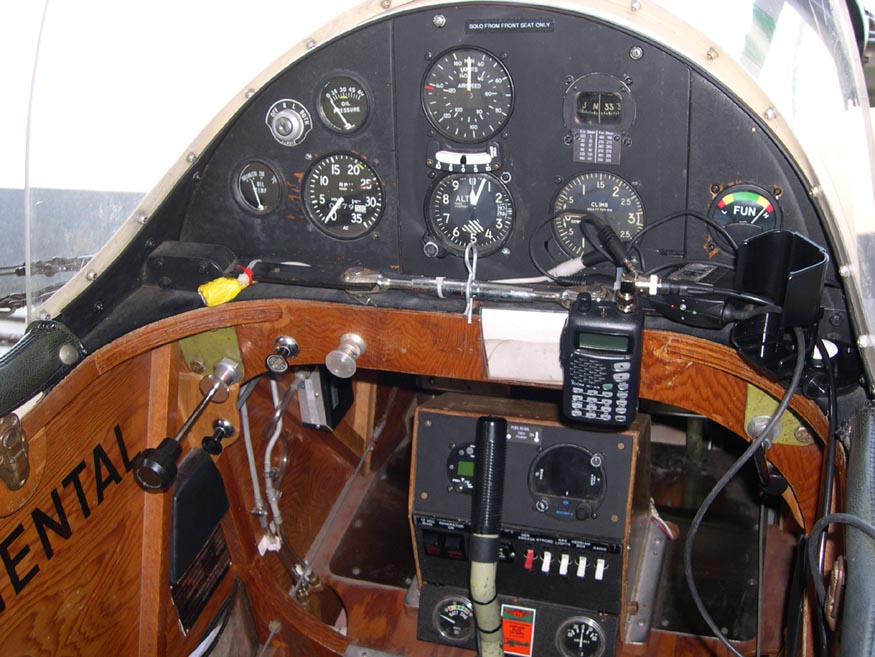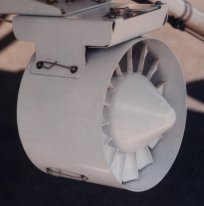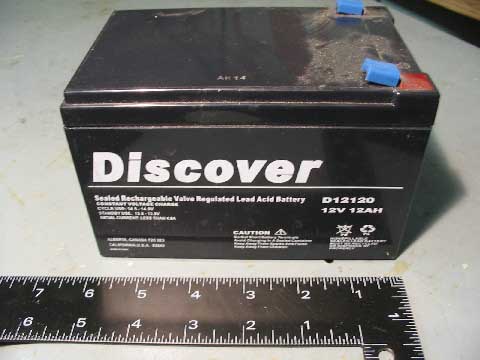Surviving Without an Electrical System
June 2008
With contributions from Drew Fidoe
You don't really miss it until it's gone.
The Seattle area had a real bad windstorm in a rough December a year
and a half back. Despite living in the heart of the urban area,
our power went out and stayed gone.
It was kinda fun, an adventure, on the first night. I cooked
up a huge batch of thawing meat on the gas grill, we pulled a
cozy couch up close to the gas fireplace, watched TV on a teeny-tiny
"Watchman", and piled extra comforters on the bed.
But it got old...DARN old...after the second night. The house
had cooled to the low '50s, and it was getting boring sitting around
all evening trying to read paperback books by flashlight wrapped up in
layers of sweatshirts and blankets. By the time power came back
(about five days after the storm), we'd come to a new appreciation of
how fundamental electricity was to our lives.
The same reaction can hit Fly Baby builders, too, when they
contemplate installing an engine without a generator on their
airplane. The shock (so to speak...) hits them as they
contemplate what they'll have to do without. A starter, lights,
transponder, maybe even a comm radio.
Why do it, then?
There are a couple of good reasons. First, the lowest-cost
Continental engines are A65s, most of which don't have provisions for
starters and generators. If you're looking for the cheapest
way to get in the air, the no-generator A65 is the answer.
Second, the "overhead" involved with electrical systems on
aircraft is tremendous. You'll need a generator. A
battery. Wires. Fuses and fuse holders.
Switches. Connectors, jacks, plugs, insulated wire holders,
meters, etc., etc. etc. Not only does it have to be installed and
checked out, it's something that can go wrong over the years and have
you tearing your hair out trying to fix. When I look back to the
problems my Fly Baby has presented me in twelve
years of ownership, 90% of it has been related to the electrical system
or avionics. Plus, there's weight...a stock starter and generator
plus a conventional battery probably weighs 40-50 pounds. That's
5% of your gross weight!
Throw out the darn stuff, I say. Install just what you're going to
need, to support the kind of flying you plan to do.
Earlier this year, one builder was getting close to completion, and
emailed me for some advice as to how much of an electrical system he
needed. I cc'd Stringbag's owner, Drew Fidoe, and together we
came up with some advice.
Let's look at some aspects of the no-electrical-system world.
No Starter
If you won't have a starter, do one thing for me, first off:
Pile up a stack of bibles, Torahs, Korans, cases of Scotch Whiskey,
bunny rabbits, or WHATever you consider holy, and please swear: "I will never hand-prop my
airplane unless it's tied to something so it can't get away."
People are afraid of being hit by the prop, but in ~25 years, I've only
met one guy who has been injured by the prop when hand-propping.
But I've met a half-dozen or more that had their planes run away from
them.
 The best solution
for securing the airplane is a remote-release hook, like I describe in
a separate article. If you don't
want to build one you can buy a glider hook from Wag-Aero; they're
probably nearly $400 by now, but it gives you the advantage of a known
quantity.
The best solution
for securing the airplane is a remote-release hook, like I describe in
a separate article. If you don't
want to build one you can buy a glider hook from Wag-Aero; they're
probably nearly $400 by now, but it gives you the advantage of a known
quantity.
Carry a hank of rope and a good knife in the plane at all times.
Normally, if you stop somewhere, you can just grab a loose tiedown rope
to loop through the hook. Otherwise, you can cut off a bit of
your rope to tie to a fencepost or something and leave it behind as you
taxi away.
I flew N500F for seven years, in that time I only propped the plane
once without having either someone in it or the tailhook secured.
Once was when the engine went to sleep on final when I was landing on a
15-degree day. I coasted off onto the turnoff, then got out and
flipped it to get it going again. The second time was when I was
in the middle of a big private field with no one around and
nothing available to tie do.
My normal practice at home was to tie the tail to the hook and put
chocks on both wheels. I'd start the engine, amble around and
pull the chocks, then climb in, bolt myself onto the airplane, and
reach down and pull the release handle.
Away from home, I just used the tail hook, but made sure the plane was
POINTED somewhere safe, and made double-sure the throttle was at idle
when I flipped the prop. Especially after I didn't, and the engine
started up at full throttle (the tailhook saved me).
Careful of folks who step up and offer to prop you; they PROBABLY have
experience, but maybe not.
Remember, though, that if they're pilots, you can put them in the
cockpit to hold the brakes while YOU prop. Tie down the plane
normally, use the tailhook, do all the switch-flipping, etc. yourself,
but have the guy in the cockpit to "guard the switches". Show him
the mags so he can cut them off if necessary.
When I've been at real weird out-of-the-way places, I've stationed
non-pilots to stand by the cockpit with their sweaty hand on the mag
switches and instructions on how to turn it off if things go bad.
Again, YOU'RE doing all the control and switch manipulation; they're
just there for a backup.
Finally, on hand-propping, make sure you get a bit of
instruction. The big things are to watch your footing (you don't
want to slip) and don't be TOO scared of the prop (if you're scared,
you'll stand too far away and be leaning TOWARDS the prop).
Drew adds:
If
the engine is going to be
hand-propped, does it have at least one magneto with an impulse
coupler? If not, I recommend setting one mag around 5 - 10
degrees aft
of top dead centre, and practice starting the engine on that retarded
mag. Starting the engine on a retarded magneto will greatly
minimize
propeller kick back and facilitate "first starts" after overhaul or
reactivation. Once some safe practice is complete, and any engine
glitches attended to, set the mag for standard advance prior to
flight. I learned this one the hard way...
Comm Radio
 Lots of Fly Baby
drivers, including myself, use handheld radios. They work
fine. Rechargeable batteries tend to self-discharge on their own,
though, so I kind of like the idea of using normal Alkalines.
Carry a spare set of batteries in the cockpit so you can get to them
in-flight if you absolutely have to (See also the "Battery
Only"discussion below).
Lots of Fly Baby
drivers, including myself, use handheld radios. They work
fine. Rechargeable batteries tend to self-discharge on their own,
though, so I kind of like the idea of using normal Alkalines.
Carry a spare set of batteries in the cockpit so you can get to them
in-flight if you absolutely have to (See also the "Battery
Only"discussion below).
Handheld radios put out a decent amount of transmit power, but their
main limiting factor is usually that darned "rubber-duckie"
antenna. Most handheld antennas attach with a standard BNC
connector, so you can install a "real" antenna on the airplane and hook
it up to the radio. With my setup, I hear planes in patterns ~60
miles away, and people say they can hear me just fine.
You can buy a commercial aircraft comm antenna for $50 or so, or you
can try out my homebuilt antenna.
The ultimate solution for hand-held radios, of course, is what I did
with my ICOM: Installed it in the panel, power it from the
aircraft power bus, and run a remote antenna. See the separate article. You operate it just
like a regular aircraft radio.
Transponder
First off, you have to determine whether the areas you want to fly in
require a transponder.
In the US, you need a transponder to operate within Class A, B, or C
airspace. You do not
need one to operate from the typical controlled field, which are
located in Class D airspace (but, of course, if the field itself is in
Class B or C, you'll need one...).
In addition, a transponder is required if you're going to operate
within the 30 nm "Veil" around the airport at the center of a Class B
airspace. However, there's an important provision of the rule to
be aware of. The applicable reg is 14CFR 91.215 (b)(3):.
Here it is in context:
(b) All airspace. Unless otherwise authorized or
directed by ATC, no person may operate an aircraft in the airspace
described in paragraphs (b)(1) through (b)(5) of this section, unless
that aircraft is equipped with an operable coded radar beacon
transponder...
(b)(2)
All aircraft. In all airspace within30 nautical miles of an airport
listed in appendix D, section 1 of this part from the surface upward to
10,000 feet MSL;
(b)(3)
Notwithstanding paragraph (b)(2) of this section, any aircraft which
was not originally certificated with an engine-driven electrical system
or which has not subsequently been certified with such a system
installed, balloon or glider may conduct operations in the airspace
within 30 nautical miles of an airport listed in appendix D, section 1
of this part provided such operations are conducted—
(i)
Outside any Class A, Class B, or Class C airspace area; and
(ii)
Below the altitude of the ceiling of a Class B or Class C airspace area
designated for an airport or 10,000 feet MSL, whichever is lower;
So: In the US, you can operate within the 30 nm Class B Veil if
your airplane does not have an "engine-driven electrical system."
What constitutes such a system? The FAA has said the airplane
must include all three of these items:
- A generator or alternator turned by the engine of the aircraft.
and
- A regulator to condition the power generated by the alternator or
generator, and
- A battery
Get rid of any of these three items, and you don't have to have a
transponder for flying inside the Class B Veil (you DO still need a
transponder to actually enter the Class B or C airspace, though).
 The obvious thing
to get rid of , here, is the generator and regulator and just operate
on the battery alone...What engineers call a "Total Loss System."
Install just a battery and charge it up in your hangar or at home
between flights. My generator wasn't working right for over a
year, and I managed just by slapping a charger on it when I put it in
the hangar. I have a starter, and had no problems with the five
or six starts I did during a typical jaunt.
The obvious thing
to get rid of , here, is the generator and regulator and just operate
on the battery alone...What engineers call a "Total Loss System."
Install just a battery and charge it up in your hangar or at home
between flights. My generator wasn't working right for over a
year, and I managed just by slapping a charger on it when I put it in
the hangar. I have a starter, and had no problems with the five
or six starts I did during a typical jaunt.
But....usually, some folks' eyes start lighting up, here. "What
about a wind generator!!!?"
It's absolutely true that a wind-driven generator does NOT qualify as
an "Engine-driven electrical system." If you have one, you don't
need a transponder to operate within the Class B Veil.
While there have been certified aircraft that have used wind
generators, they're pretty rare. They produce a lot of drag, and
they really don't generate that much power. See Harry Fenton's take on them.
Note that the above "loophole" for aircraft without engine-driven
electrical systems only applies to flying in the US. Drew Fidoe
has this comment for his fellow Canadians:
If
you are in Canada and flying in Class C airspace there is no waiver or
grandfathering unless you are a glider. No transponder no
airspace.
I am flying out of one of the busiest
airports in Canada, in an aircraft with no engine driven
electrics. Really, once I got my less than perfect wiring tweaked
and remember to charge the battery (and turn off all switches after
flying...check list check list :) flying battery only is a
non-issue.
Flying Battery-Only
If
you don't have a starter, you really don't need that big of a
battery.
Drew has a motorcycle battery stuck in his floorboards. It's easy
enough to put a trickle charger on them (if you've got a closed hangar)
or to just pull it out and take it home. If you do the latter,
buy two
and just keep one a'charging at home. Here's an article on Batteries and Fly Babies.
Drew adds:
 I use
the 12 amp-hour GEL cell in the photo. Using a modern, Garmin
transponder and an A-5 ICOM hand-held radio I seem to be good for about
4 to 5 hours of continual transponder and radio work. The
Transponder
and radio both have low-voltage cut-outs, which is good for saving the
GEL cell battery as they do not tolerate getting fully
discharged. I
carry the standard ICOM radio battery as a back-up. The ICOM is
more
sensitive to low voltage than the Transponder, and will normally shut
off when transmitting indicating low power. Then I have to either
change batteries or shut the Tx off. Since there is no engine
driven
electrical the "low power" indication always comes on the radio when I
am transmitting, this isn't an issue, only when the low power
indication stays on is when I'm going to have trouble. This only
happened a couple of time before I realized the "problem".
I use
the 12 amp-hour GEL cell in the photo. Using a modern, Garmin
transponder and an A-5 ICOM hand-held radio I seem to be good for about
4 to 5 hours of continual transponder and radio work. The
Transponder
and radio both have low-voltage cut-outs, which is good for saving the
GEL cell battery as they do not tolerate getting fully
discharged. I
carry the standard ICOM radio battery as a back-up. The ICOM is
more
sensitive to low voltage than the Transponder, and will normally shut
off when transmitting indicating low power. Then I have to either
change batteries or shut the Tx off. Since there is no engine
driven
electrical the "low power" indication always comes on the radio when I
am transmitting, this isn't an issue, only when the low power
indication stays on is when I'm going to have trouble. This only
happened a couple of time before I realized the "problem".
I
normally simply keep the battery on a "battery maintainer" or "smart
charger" after every second or third flight. I use a battery
saver on
the radio like Ron does, I used the fitted cigarette adapter but it was
very unreliable and instead hardwired the battery saver directly to my
electrical.
If you travel somewhere and intend to RON, don't forget to bring a
charger for your radio and/or the battery in your airplane. Drew
adds: For travelling away
overnight (if I
ever do this) I have a solar cell panel which I plan to leave in the
sunlight, use transponder only when absolutely necessary, and if near
and plugs will bring my charger with me.
Don't forget to install a fuse on the power line to the radio.
Don't use the plastic in-line fuse holders; these get brittle with age
and break. Auto parts stores sell holders for single-blade type
fuses; I've got some of those and think they work well.
Drew's final comment:
Please
use fuses and breakers, one friend nearly burned is Fly Baby and a new
Microair Transponder in the process, when a wire was mistakenly shorted
out! I have breakers and fuses for the transponder, radio and
other electrics.
Comments? Contact Ron Wanttaja
.
 The obvious thing
to get rid of , here, is the generator and regulator and just operate
on the battery alone...What engineers call a "Total Loss System."
Install just a battery and charge it up in your hangar or at home
between flights. My generator wasn't working right for over a
year, and I managed just by slapping a charger on it when I put it in
the hangar. I have a starter, and had no problems with the five
or six starts I did during a typical jaunt.
The obvious thing
to get rid of , here, is the generator and regulator and just operate
on the battery alone...What engineers call a "Total Loss System."
Install just a battery and charge it up in your hangar or at home
between flights. My generator wasn't working right for over a
year, and I managed just by slapping a charger on it when I put it in
the hangar. I have a starter, and had no problems with the five
or six starts I did during a typical jaunt.